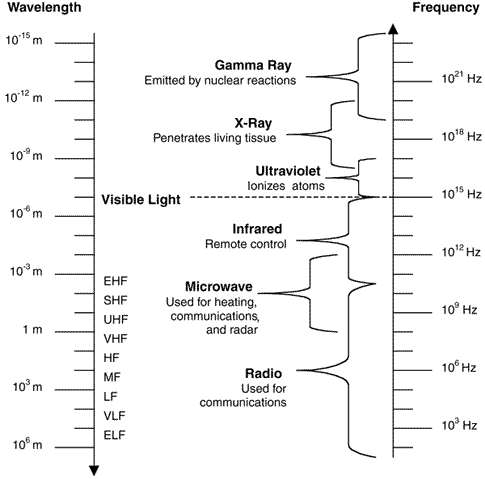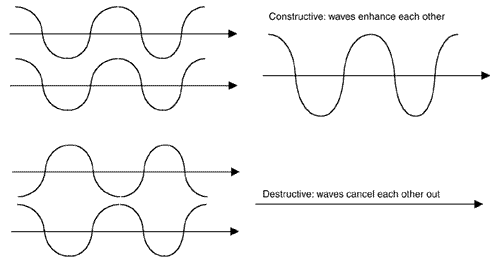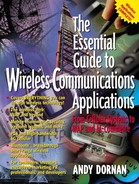Radio 101
Radio signals are a type of electromagnetic radiation, a category that also includes light, infrared, and many other types of ray. They are usually thought of as transverse waves, which means they have a wavelength and a frequency. The wavelength is the distance between the peaks of sequential waves, shown in Figure 2.1, and the frequency is the number of wave cycles occurring each second.Cycles per second are usually called hertz (Hz), after Heinrich Hertz, the physicist who discovered radio.
The speed of a transverse wave can be calculated by multiplying the frequency and the wavelength, but all radio waves automatically travel at a constant speed—the speed of light, which in empty space is exactly 299,792,458 meters per second. Passing through any material slows it down slightly, but air and even clouds are so thin that for wireless communications, the speed can still be thought of as around 300,000 km per second.
The constant speed means that as frequency is increased, wavelength is shortened. It's easy to calculate each from the other, so only one is ever specified. Unfortunately, conventions about which should be used have changed through the history of radio; modern scientists prefer frequency, but older equipment and even the names of different types of radiation use wavelength.
The amplitude of a wave is its height, measured from the axis to the peak. This represents the power of the transmission, or how loud it is. Amplitude usually decreases as a wave moves further away from its source and spreads over a wider area, a phenomenon called divergence. Waves moving through anything other than a vacuum also experience attenuation, or loss of energy to, for example, air molecules.
Figure 2.1. A transverse wave

normal: ScaleMost electromagnetic waves have frequencies far higher than 1 Hz. To avoid having to write large numbers out in full, radio engineers use several prefixes based on International System (or SI, for Système International d'Unité) metric units: 1 kilohertz (kHz) = 1,000 or 103 cycles per second 1 megahertz (MHz) = 1,000,000 or 106 cycles per second 1 gigahertz (GHz) =1,000,000,000 or 109 cycles per second 1 terahertz (THz) = 1,000,000,000,000 or 1012 cycles per second 1 petahertz (PHz) = 1,000,000,000,000,000 or 1015 cycles per second Conversely, wavelengths are often smaller than 1 meter, particularly for the types of radio used by modern communications systems. 1 millimeter (mm) = .001 or 10-3 m 1 micrometer (m) = 0.000 001 or 10-6 m 1 nanometer (nm) = 0.000 000 001 or 10-9 m 1 picometer (pm) = 0.000 000 000 001 or 10-12 m 1 femtometer (fm) = 0.000 000 000 000 001 or 10-15 m The only area where SI prefixes aren't used exactly is in computing, where a kilobyte (kB) is actually 1,024 bytes, and a megabyte (MB) is 1,048,576 bytes. Communications technologies do use exact thousands and millions, so 1 kbps = 1,000 bps. This can be important because programs such as Web browsers usually show data rates in kB or MB per second. As data rates get higher, the difference between the communications and the computing measurements becomes more significant. 1 byte per second = 8.0 bps 1 kB per second = 8.19 kbps 1 MB per second = 8.39 Mbps 1 GB per second = 8.59 Gbps |
Radio and Radiation
The complete range of electromagnetic radiation is known as the spectrum. Radio waves lie at one end of it, with a lower frequency and a longer wavelength than other kinds of radiation. The spectrum is a continuum; the boundaries between different types don't exist naturally, but were invented by scientists trying to classify them. This means that there is some disagreement about where exactly they lie, and some overlap. The complete spectrum is illustrated in Figure 2.2.
Figure 2.2. The electromagnetic spectrum

Radio is the name given to the types of electromagnetic wave that can be used for communication purposes. Its scope is expanding all the time, thanks to new technology. At the low frequency end, waves of around 5 kHz have been used to send signals underwater. At the upper limit, the overlap between radio waves and microwaves became particularly valuable in the late twentieth century because this region can be used for high capacity communications over a relatively small area. Microwave radio is employed by all cellphone systems and most satellites.
Electromagnetic waves are generated whenever a moving electric charge is accelerated, which means a change in either its speed or direction. A radio transmitter works by vibrating electrons, the charged particles that surround all atoms and are responsible for electricity. The frequency of the wave depends on how fast the electrons are vibrating; the faster they move, the higher the frequency. A receiver uses the same principle in reverse. The waves stir up electrons in the antenna, creating electric currents.
Beyond the radio spectrum, higher frequency waves are produced and absorbed in the same way. A lightbulb is essentially just a transmitter, which heats electrons so that they vibrate millions of times faster than those in a radio antenna. Likewise, eyes are receivers, tuned to interpret radiation at those high frequencies.
Waves at even higher frequencies than visible light can strike electrons so hard that they are knocked free of their atoms, a process called ionization. Ionizing radiation is extremely dangerous to living things, which is why the word radiation has become, to many people, synonymous with danger and death. Radio waves are way below these ionization frequencies, so they are not harmful in the same way as ultraviolet or nuclear radiation. But this does not mean they are entirely safe; they do cause heat, as anyone who uses a microwave oven knows.
Bands
The radio spectrum is subdivided into a series of regions known as wavebands. Table 2.1 shows the names and uses of these, in order of increasing frequency. Although now named after frequencies, the bands were originally defined in terms of wavelengths, hence the convenient powers of ten.
Because frequency is measured on a logarithmic scale, each band contains ten times the spectrum of the one above it in the table. For example, there is a thousand times as much spectrum in the UHF band, used for most broadcast TV, than in the MW band, used for most AM radio. This means that the high frequency bands are most useful for fast data services, while the lower ones are suitable only for broadcasting.
Spectral bandwidth is not the only difference between the bands. Signals at high frequency have a much shorter range than at lower frequencies because the shorter wavelengths suffer greater attenuation. As radiation frequency gets higher, more things are able to block it. That's why high frequency light can't pass through walls, while lower frequency radio can. Ionizing radiation can be blocked entirely by gas, which is fortunate for us—much of the deadliest radiation from the sun is (or used to be) stopped by the ozone layer, a region of slightly larger molecules.
This effect of attenuation is particularly apparent in broadcast radio. Stations in the LW band are able to cover several European countries with a single transmitter, while those in the VHF band typically serve only a single city. The short range is a problem when trying to communicate across a great distance, but can be a benefit when designing a cellular network, as it means that different cells can reuse the same spectrum. Satellite systems use high frequencies but extend the range by using very powerful transmitters and, in many cases, a parabolic dish to focus the radiation.
Many frequencies in the HF band are able to travel right around the world by reflecting off the ionosphere, a layer of charged particles in the upper atmosphere. Before satellites, this was the only way of communicating across oceans, but it is very unreliable. Because the ionosphere depends on radiation from the sun, it intensifies with sunspot activity and gets thinner at night. Nevertheless, a shortwave radio receiver can be used to hear broadcasts from around the world.
| Wavelength | Frequency | Common Name | Main Purposes |
|---|---|---|---|
| Above 100 km | Below 3 kHz | Extremely Low Frequency (ELF) | Submarine communications |
| 10–100 km | 3–30 kHz | Very Low Frequency (VLF) | Maritime communications |
| 1–10 km | 20–300 kHz | Low Frequency (LF) or Long Wave (LW) | AM broadcasting |
| 100–1000 m | 300–3000 kHz | Medium Frequency (MF) or Medium Wave (MW) | AM broadcasting |
| 10–100 m | 3–30 MHz | High Frequency (HF) or Short Wave (SW) | AM broadcasting, amateur radio |
| 1–10 m | 30–300 MHz | Very High Frequency (VHF) | FM broadcasting, TV |
| 0.1–1 m | 300–3000 MHz | Ultra High Frequency (UHF) | TV, cellphones |
| 10–100 mm | 3–30 GHz | Super High Frequency (SHF) | Fixed wireless, satellites |
| 1–10 mm | 30–300 GHz | Extra High Frequency (EHF) | Satellites, radar |
Microwaves
The UHF, SHF, and EHF bands are lectively known as microwaves because of their small wavelengths—small compared to other radio waves, not to the electromagnetic spectrum as a whole. Their high bandwidth and short range makes them very useful for communications. They do have disadvantages, notably that they are easily blocked by obstacles such as walls and hills, and weakened by rain and cloud.
The microwave spectrum is subdivided into bands, shown in Table 2.2. Most digital cellphones use the S-band, while satellites often transmit in the K-band and receive in the C-bands. However, all have some purpose in wireless communications.
Interference
Two radio waves traveling in different directions can pass harmlessly through each other, no matter what the frequency. However, if a receiver happens to pick up two or more signals at the same frequency, it has no way to distinguish one from the other. Unwanted signals are called interference and can severely limit the effectiveness of a radio signal.
Some interference is much louder than the real signal, effectively drowning it out. This happens to satellites when they align with the sun, a much more powerful source of radiation than any communications satellite, but only for few minutes each year. More common is for two similar communications signals to meet, either reinforcing each other or canceling each other out.
Wave signals are superimposed on each other, so the effects of two on the same frequency depends on how their cycles are aligned. If both go through peaks and troughs at the same time, they add together to make a stronger signal, a situation known as constructive interference. If one is at a peak while the other is at a trough, they will cancel each other out entirely, a process called destructive interference.. Figure 2.3 illustrates constructive and destructive interference.
To ensure that radio signals remain free of interference, frequencies have to be carefully planned and controlled. However, interference does have some applications. Lasers use the constructive type to increase the energy of their beam. Destructive interference is not yet used with electromagnetic radiation, but it has been applied with great success to quiet unwanted sound waves. The same principle could work with radio, jamming a transmission in such a way that it appears never to have been sent, or even helping to reduce nuclear radiation.
Figure 2.3. Constructive and destructive interference

normal: Surfing on What?Waves as we know them have to travel through something; sound waves go through the air, water waves through the sea. But what do electromagnetic waves move through? This question greatly bothered scientists at the end of the nineteenth century. Eventually, they invented a medium called the luminiferous aether, which they said filled the Universe. Trouble was, experiments showed that the aether didn't exist. In 1905, Albert Einstein published a theory that explained electromagnetic radiation as tiny particles called photons, which often behaved like waves. The frequency depends on the energy of each photon, while the signal strength or amplitude corresponds to the number of photons. Sixteen years later, Einstein was awarded a Nobel Prize for this discovery, rather than for his better-known theory of relativity. So, is radiation made from waves or particles, or from something in between? A century after Einstein's insight, we still don't know. Both explanations work, so scientists are free to choose whichever is most convenient. Most radio engineers prefer to do their calculations using waves, but photons are often used when discussing fiber optics and some satellite applications. |
